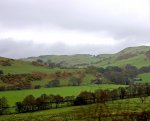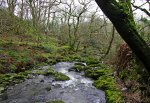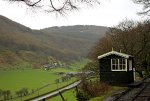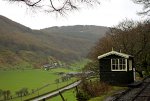Introduction
The Talyllyn Railway is a narrow gauge railway in Meirionnydd, Mid Wales that was originally built to carry slate from the hills above Abergynolwyn to the wharves at Tywyn. It was made famous as Skarloey’s railway by Rev Awdry in his Thomas the Tank engine books. The railway still preserves the feel of the 1950s and is a lovely ride up the Afon Fathew valley.
The railway was opened in 1866 and has an illustrious history. It was the first narrow gauge railway in Britain to carry passengers using steam locomotives. The line never closed and is the oldest narrow gauge railway still running in Britain, as well as the first of the narrow gauge railways to be preserved by volunteers. It still has its two original locos (Talyllyn and Dolgoch) as well as many of the original carriages.
These two locos have been joined by Edward Thomas and Sir Hadyn from the nearby closed Corris Railway. Douglas later joined them and was followed by Tom Rolt, built in the Talyllyn workshops.
Locos and coaches are in immaculate condition and provide a lovely leisurely trip up the valley to the terminus at Nant Gwernol. On the way back there is a 30 minute refreshment stop at Abergynolwyn, before continuing to the terminus at Nant Gwernol which has no road access. There is no sense of hurry. This is a railway to sit back and enjoy the scenery as you pass the small isolated farms scattered up the valley.
A Brief History
Slate was needed to roof the houses of the rapidly expanding cities of industrial Britain and the best roofing slate was found in North Wales. Originally slate was carried by pack horse or on sleds. At their peak the quarries at Bryn Eglwys employed over 300 men and so much slate was produced a new method of transport was needed. The nearby Ffestiniog Railway was already using steam engines to carry slate and the Talyllyn soon followed. The line opened in 1866 and was soon running regular slate and passenger trains. Small halts served the isolated farms along the valley.
At the beginning of the C20th, the enterprise was not making money and the Bryn Eglwys quarries, Abergynolwyn Estate and village and the Talyllyn Railway were put up for sale. It was bought by the local MP, Sir Henry Hadyn Jones, who was concerned about the distress and problems caused if the quarry closed. Although demand for slate fell with the introduction of roofing tiles between the wars, the quarries struggled on until 1946 when a main rock fall led to their closure. The railway continued to run although on a very reduced service on 2 or 3 days a week, assuming there was a loco able to pull the train. The precarious condition of the railway meant, unlike the Vale of Rheidol Railway, it was not included in the 1947 Transport Act that nationalised Britain’s railways.
When Sir Hadyn died in 1950, a group of enthusiasts lead by the railway author, Tom Rolt, and Edward Thomas, who had worked for the company for 53 years, met with Sir Hadyn’s widow. The Talyllyn Railway Preservation Society was formed to take over the railway. They set forward a plan to run the railway using volunteer labour as well as funding from membership fees and gifts. Tom Rolt was appointed General Manager. It was the first time anything like this had been tried and was the start of the narrow gauge railway preservation movement
The Society ran their first train in 1951 to Rhydyronen, as the track beyond was in too poor condition. Trains were run using Dolgoch, with help from two new locos from the Corris railway, renamed Sir Hadyn and Edward Thomas.
In 1953, the Territorial Army helped restore the track above Rhydyronen and another loco named Douglas arrived along with more coaches. In 1957, the BBC did a live broadcast from the railway and passenger numbers doubled. It was very much on the tourist map and passenger facilities were improved at Twywn and Abergynolwyn.
The original line ended at Abergynolwyn and there were two cable worked inclines to the quarries above Nant Gwernol. Landowners were traced and land bought to extend the line as a light railway to a new terminus at Nant Gwernol, which opened in 1976. A new loco, Tom Rolt, was built in the Society’s workshop at Pendre.

The Talyllyn Railway is a narrow gauge railway in Meirionnydd, Mid Wales that was originally built to carry slate from the hills above Abergynolwyn to the wharves at Tywyn. It was made famous as Skarloey’s railway by Rev Awdry in his Thomas the Tank engine books. The railway still preserves the feel of the 1950s and is a lovely ride up the Afon Fathew valley.
The railway was opened in 1866 and has an illustrious history. It was the first narrow gauge railway in Britain to carry passengers using steam locomotives. The line never closed and is the oldest narrow gauge railway still running in Britain, as well as the first of the narrow gauge railways to be preserved by volunteers. It still has its two original locos (Talyllyn and Dolgoch) as well as many of the original carriages.
These two locos have been joined by Edward Thomas and Sir Hadyn from the nearby closed Corris Railway. Douglas later joined them and was followed by Tom Rolt, built in the Talyllyn workshops.
Locos and coaches are in immaculate condition and provide a lovely leisurely trip up the valley to the terminus at Nant Gwernol. On the way back there is a 30 minute refreshment stop at Abergynolwyn, before continuing to the terminus at Nant Gwernol which has no road access. There is no sense of hurry. This is a railway to sit back and enjoy the scenery as you pass the small isolated farms scattered up the valley.
A Brief History
Slate was needed to roof the houses of the rapidly expanding cities of industrial Britain and the best roofing slate was found in North Wales. Originally slate was carried by pack horse or on sleds. At their peak the quarries at Bryn Eglwys employed over 300 men and so much slate was produced a new method of transport was needed. The nearby Ffestiniog Railway was already using steam engines to carry slate and the Talyllyn soon followed. The line opened in 1866 and was soon running regular slate and passenger trains. Small halts served the isolated farms along the valley.
At the beginning of the C20th, the enterprise was not making money and the Bryn Eglwys quarries, Abergynolwyn Estate and village and the Talyllyn Railway were put up for sale. It was bought by the local MP, Sir Henry Hadyn Jones, who was concerned about the distress and problems caused if the quarry closed. Although demand for slate fell with the introduction of roofing tiles between the wars, the quarries struggled on until 1946 when a main rock fall led to their closure. The railway continued to run although on a very reduced service on 2 or 3 days a week, assuming there was a loco able to pull the train. The precarious condition of the railway meant, unlike the Vale of Rheidol Railway, it was not included in the 1947 Transport Act that nationalised Britain’s railways.
When Sir Hadyn died in 1950, a group of enthusiasts lead by the railway author, Tom Rolt, and Edward Thomas, who had worked for the company for 53 years, met with Sir Hadyn’s widow. The Talyllyn Railway Preservation Society was formed to take over the railway. They set forward a plan to run the railway using volunteer labour as well as funding from membership fees and gifts. Tom Rolt was appointed General Manager. It was the first time anything like this had been tried and was the start of the narrow gauge railway preservation movement
The Society ran their first train in 1951 to Rhydyronen, as the track beyond was in too poor condition. Trains were run using Dolgoch, with help from two new locos from the Corris railway, renamed Sir Hadyn and Edward Thomas.
In 1953, the Territorial Army helped restore the track above Rhydyronen and another loco named Douglas arrived along with more coaches. In 1957, the BBC did a live broadcast from the railway and passenger numbers doubled. It was very much on the tourist map and passenger facilities were improved at Twywn and Abergynolwyn.
The original line ended at Abergynolwyn and there were two cable worked inclines to the quarries above Nant Gwernol. Landowners were traced and land bought to extend the line as a light railway to a new terminus at Nant Gwernol, which opened in 1976. A new loco, Tom Rolt, was built in the Society’s workshop at Pendre.
Last edited:





